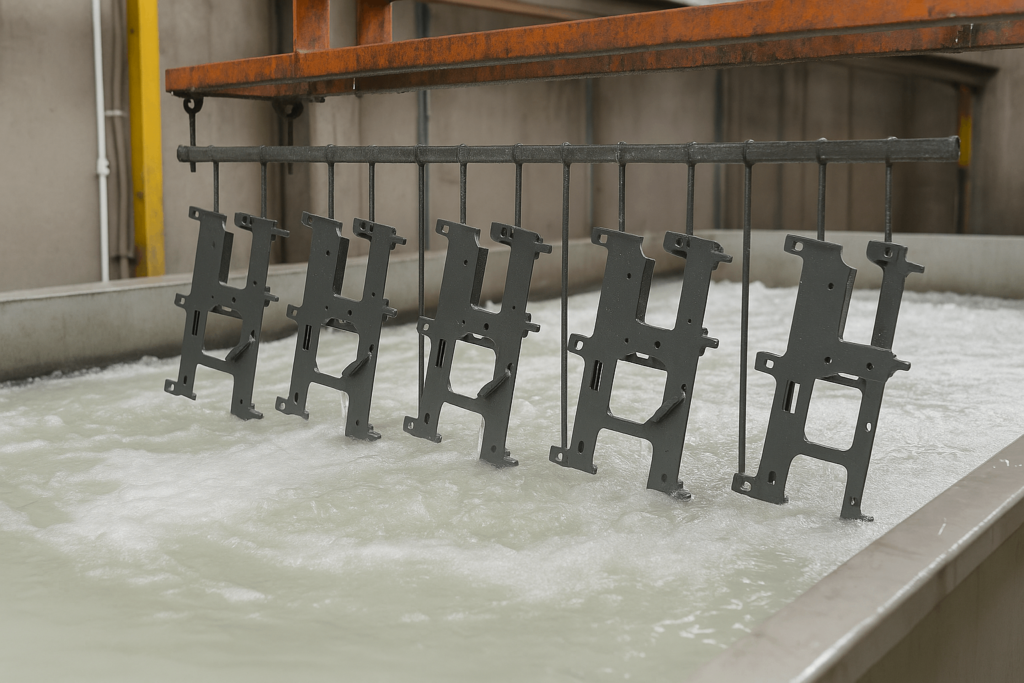E-coating (also known as electrophoretic deposition or electrocoating) is widely used in automotive, appliance, and metal parts manufacturing. This guide is compiled by surface finishing engineers with over two decades of hands-on experience, drawing on ASTM standards and global case data.
What Is E-Coating and Why It’s a Smart Choice for Wholesale Metal Products
If you’re a wholesale buyer sourcing metal enclosures, frames, brackets, or custom assemblies, surface quality directly affects lifespan, return rates, and customer satisfaction. This guide explains what e-coating is and how it enhances durability in bulk custom metal finishing, especially in wholesale metal finishing solutions.
E-coating is an industrial metal coating process using electric charge to apply paint uniformly—even inside complex geometries—providing superior anti-corrosion protection for steel enclosures and fabricated parts.
How to Spot Hidden Coating Risks in Your Supply Chain
Small surface defects on metal parts—such as rust, peeling paint, or edge chipping—may seem insignificant. But in wholesale manufacturing, these flaws can multiply and lead to serious operational and financial consequences.
Common Failure Modes in Inadequate Coating Applications
Filiform Corrosion: Corrosion under paint from untreated edges.
Weld Corrosion: Weak protection on heat-affected joints.
Edge/Recess Exposure: Missed spots from spray techniques.
These flaws reduce product lifespan and increase end-user complaints.

Real Cost Impact for Bulk Metal Product Buyers
Quality issues in coating can lead to:
Shipping delays due to returns
Labor time spent on rework
Loss of buyer trust and reputation
Global corrosion losses exceed $2.5 trillion annually. For B2B buyers, prevention through advanced coating processes is far more cost-effective.
🔍 Case insight: One of our European vending machine clients reduced rust-related returns by 95% within one year after switching from spray primer to CED e-coating.
How E-Coating Works and Why It Outperforms Spray Primers
E-coating uses electric current to bond paint particles to metal parts. It reaches corners, edges, and recesses—anywhere current flows. Results include:
Even film thickness (15–35μm)
Weld and edge protection
No overspray or pooling

Compared to Traditional Primers:
✅ E-Coat forms an electrochemical bond—more consistent and durable than manual spray methods.
When to Use Cathodic E-Coating (CED) in High-Volume Manufacturing
Cathodic E-Coating (CED) is the standard e-coating service for manufacturers in industries like automotive, vending, and metal cabinet fabrication due to its unmatched durability.
Why Use CED:
Provides 1000+ hours of salt spray resistance (ASTM B117)
Offers high hardness (H–2H, ASTM D3363) for mechanical durability
Effectively coats welded, bent, or complex-shaped steel parts
CED is especially effective for structural or functional components in OEM production and serves as a reliable solution for custom e-coating services for metal fabricators.
How the E-Coating Process Ensures Uniform Results in Bulk Runs
Every protective layer starts with strict preparation.
E-Coating Line Overview:
Degreasing – Removes oil and debris
Multi-stage Rinsing – Eliminates contamination
Phosphate Coating – Enhances paint bonding
E-Coat Bath – Electric deposition coating
Rinse & Bake – Removes excess and cures film
With controlled pH, voltage, and line speed, results stay consistent even across 10,000+ parts.
How Quality Is Measured in E-Coating Services
Reliable ISO 9001-certified e coating suppliers use these metrics:
Film Thickness – 15–35μm (digital gauges)
Salt Spray Resistance – 1000+ hrs (ASTM B117)
Adhesion – 4B–5B (ASTM D3359)
Hardness – H to 2H (ASTM D3363)
Throw Power – Visual check inside cavities
Top-tier vendors document these results for every production batch.
E-Coat vs. Powder Coat – When to Use Each Finish
| Feature | E-Coat (CED) | Powder Coat |
|---|---|---|
| Main Use | Corrosion protection | Decorative finishing |
| Coating Type | Thin primer (15–35μm) | Thick topcoat (50–150μm) |
| Edge Coverage | Excellent – flows into corners | May leave exposed edges |
| Color Options | Limited (black/grey) | Wide variety |
| Best For | Internal/hidden metal parts | External, visible surfaces |
Tip: Use e-coating for metal parts with complex geometry or tight tolerances. Add powder coating for aesthetics if needed.
How E-Coating Reduces TCO and Increases Product Lifecycle Value
Don’t compare only price-per-part. Evaluate long-term performance.
Example:
Spray Primer: $1.50 each × 3% failure = $30,000
E-Coat: $2.25 each × 0.1% failure = $23,000
✅ Savings: $7,000 per 10,000 units, plus fewer complaints and better reputation.
📊 An energy storage cabinet supplier cut maintenance claims by 80% after switching to e-coating.
How to Choose the Right E-Coating Partner for OEM Orders
Must-Have Capabilities:
Salt spray & film thickness testing
ISO 9001-certified workflow
Process traceability & digital records
Experience with batch production & custom parts
Verifiable results in anti-corrosion coating performance
Red Flags to Avoid:
No test lab or documentation
No record of ASTM compliance
Inconsistent sample quality
How YISHANG Delivers Scalable, Consistent E-Coating for Global OEMs
YISHANG provides e-coating and metal fabrication services that support both high-volume runs and engineering-intensive prototypes. Our team delivers consistent outcomes for OEMs, wholesale metal buyers, and industrial equipment producers.
What You Can Expect:
Reliable corrosion protection across complex geometries
Support for prototypes and high-volume orders
Integrated design + fabrication + surface finishing
Industries we serve: electronics, vending, energy, pet products, medical, advertising, and storage.
📩 Discuss your coating needs with our engineering team.
Frequently Asked Questions (E-Coating FAQ)
Is e-coating good for aluminum?
Yes—with special pretreatment.Can I get custom colors?
Mostly black/grey. Other colors require a topcoat.Is e-coating safe and eco-friendly?
Yes. It uses water-based paint with low VOCs.Can e-coating be applied over existing paint?
No. It requires bare metal to work.How is quality measured?
Through film thickness, adhesion, hardness, and salt spray tests.Does e-coating last outdoors?
Yes—if combined with a UV-resistant topcoat, e-coating performs well in outdoor environments.Is e coating better than powder coating?
For corrosion protection and complex geometries, yes. For aesthetics and color range, powder coating is better.
Need a quote or technical input for your metal product line?
Contact our engineering team today.


